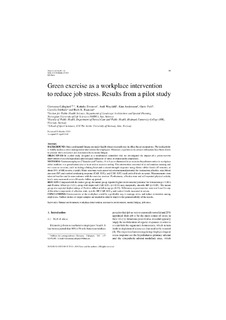| dc.description.abstract | Stress and mental fatigue are major health threats to employees in office-based occupations. Physical activity is widely used as a stress-management intervention for employees. Moreover, experiences in contact with nature have been shown to provide stress-reduction and restoration from mental fatigue. OBJECTIVES:In a pilot study designed as a randomized controlled trial we investigated the impact of a green-exercise intervention on psychological and physiological indicators of stress in municipality employees. METHODS:Fourteen employees (7 females and 7 males, 49±8 yrs) volunteered in an exercise-based intervention in workplace either outdoors in a green/nature area or in an indoor exercise-setting. The intervention consisted of an information meeting and two exercise sessions, each including a biking bout and a circuit-strength sequence using elastic rubber bands (45-minutes, at about 55% of HR reserve, overall). Main outcomes were perceived environmental potential for restoration, affective state, blood pressure (BP) and cortisol awakening response (CAR AUCG and CAR AUCI) and cortisol levels in serum. Measurements were taken at baseline and in concomitance with the exercise sessions. Furthermore, affective state and self-reported physical activity levels were measured over a 10-weeks follow-up period. RESULTS:Compared with the indoor group, the nature group reported higher environmental potential for restoration (p < 0.001) and Positive Affect (p < 0.01), along with improved CAR AUCI (p = 0.04) and, marginally, diastolic BP (p = 0.05). The nature group also reported higher ratings of Positive Affect at follow-up (p = 0.02). Differences at post-exercise were not found for any of the other components of affective state, systolic BP, CAR AUCG and cortisol levels measured in serum. CONCLUSIONS:Green-exercise at the workplace could be a profitable way to manage stress and induce restoration among employees. Further studies on larger samples are needed in order to improve the generalizability of the results. | nb_NO |

